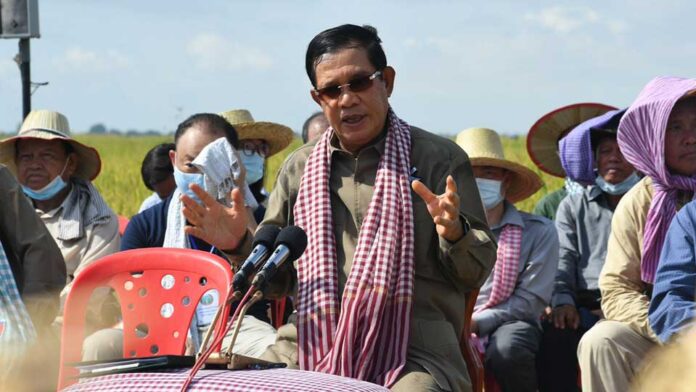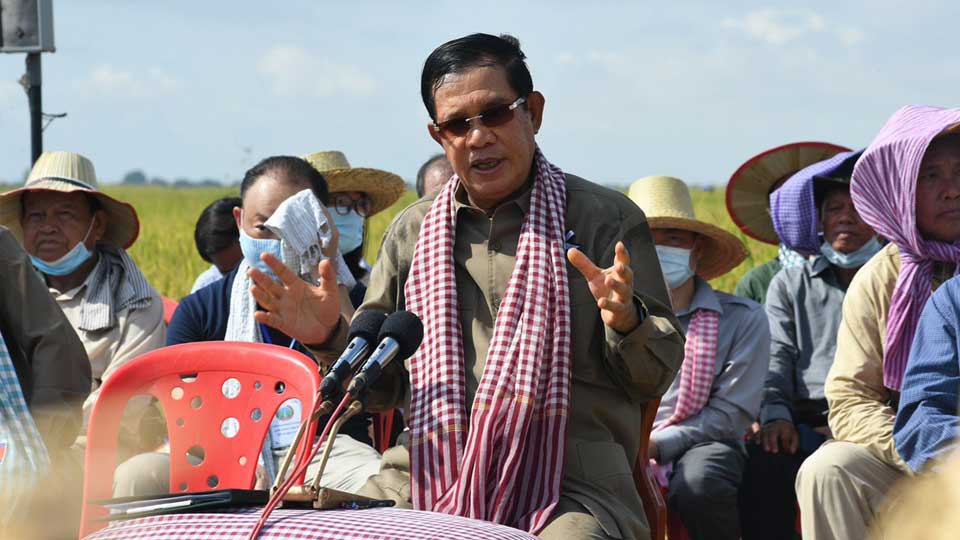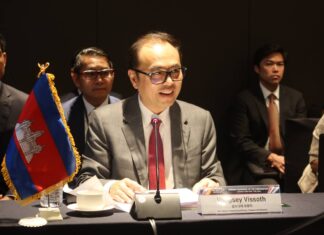To Export One Million Metric Ton of Rice Still a Target
[…] Ambassador of Australia, Excellencies, Ladies and our compatriots. Today, as I foretold in Prey Veng that I would be coming to harvest rice in Prey Kabas district of Takeo province.
It is not just harvesting in fact but also a visit to review progresses made in agriculture. Our policy to produce and export over one million metric tons of rice has stayed on as our prioritized target and it has to go along with industrial policy for 2015-2025. I should say that when we set out policy for agriculture, mainly to produce more and to export rice – the country was recording a meagre surplus. According to my calculation, as of 2002 we still had not enough rice. When Cambodia hosted ASEAN Summit, India supplied us 20,000 tons. We came through drought and flood in 2000-2001, and again drought in 2002. While launching the policy, we started to have more rice available as finally, starting this year, we have nearly six million metric tons of paddy rice, or about four million metric rice in milled rice, in surplus. Cambodia, as a small and undeveloped agriculture, has recorded a surplus of six million metric tons of paddy. It is a huge amount. We have been successful, so to speak, with rice production […] but we are falling behind the one-million metric ton of milled rice export. However, we exported, as of the first six months of this year, over 400,000 metric tons of rice. We hope to increase rice export to over one million tons by 2021 or 2022. To achieve this goal, we cannot go on with the traditional way of rice growing.
State Intervention for Farmers Abandoned – a Mistake
I could recall that in Takeo, in the district of Bati, we had had so much difficulty. It was a time when the country celebrated the water festival in 1994, and people from the commune of Put Sar of Bati district came standing in front of my house asking for assistance to get water to their rice fields. I told them to return home. I visited the district. In fact, I celebrated my water festival in the commune of Put Sar of Bati district. It might have been a wrong calculation from our part that after implementing the Paris Peace Agreement, we abandoned state intervention (in the form of) digging main canals and filling them with water for farmers. For instance, in Takeo, there has a main canal Hanuman that helps irrigate rice-planting area. Pumping machines on dispose along the canal were either out of order or inoperable for theft of spare parts. I would say it was our mistake then to have abandoned state intervention on farmers while embarking on free market economy.
Two New Ministries Created in 1998
It was then that I launched my new conceptions about agriculture. People may trace back to what I said then. I declared in the commune of Put Sar about state intervention in constructing main canal for irrigation that it would be better to have rice and to harvest it in watered field than to have nothing to harvest. People then were familiar with the medium term and long-term rice. They did not cultivate short-term rice for the fact that it was too short and difficult to harvest with sickles. I think my concept of harvesting rice in an inundated rice field is better than having none to harvest is still applicable nowadays […]
I nurtured a wish to create a Ministry of Water Resource at the time and HE Lim Kean Hor, then head of department of hydrology of the Ministry of Agriculture, followed me to various places. If we were to put more budget in agriculture, it has so many departments and not much would be available for hydrology. When the Cambodian People’s Party won the elections in 1998, I decided to set up two ministries – the Ministry of Water Resource and Meteorology and the Ministry of Land Management, Urban Planning and Construction. That was very much the background. It has always been my main thought that to achieve progress in agriculture, it is critical to have water for irrigation […]
Not Easy to Change People’s Rice Growing Practices
In those days, we implemented project by what we called “food for work.” You might still remember that people dug sub-canals to their fields connecting from the main canals in exchange for rice. That was how we did it […] I came and harvested rice with sickle in 2000 at a place near the border between Saang district of Kandal and Prey Kabas of Takeo. Twenty years later, I came back again, but I harvested rice using harvesting tractors. It is not common anymore to use sickles harvesting rice. As for this year, we have already ploughed over two million hectares out of four million hectares of land for rice cultivation and 99% of them done by agricultural machines […]
The situation has changed. I am taking this opportune moment to express my sincere appreciation for our people and the Ministry of Agriculture, Forestry and Fisheries, as well as their officials and staff involved, for their commitment and contribution to inflict great changes in our people’s attitudes/practices (towards rice cultivation). It was never easy to change people’s perceptions and practices to accept something different or new. My late father rebuked Agricultural extension workers who instructed him (about choosing a better seed) that he had grown that traditional seed for his whole life, and he was able to feed every mouth in the family. In fact, I came quite often to many parts of Takeo because Pol Saroeun was then governor.
As you already know, Takeo never practiced solidarity farming system. They gave back land to people to grow rice for themselves. In the end, Takeo became successful. As of present, Takeo has become the third biggest rice-producing province after Battambang and Prey Veng. In the time of war, while land for cultivation was inaccessible for fighting in Battambang, Takeo stood first and supplied rice to other provinces […]
Australian Helped Agriculture
Please allow me to take this opportune moment to express through HE Ambassador my sincere thanks to Australia for giving its assistance since the time it did not recognize government of the State of Cambodia, since 1988, if I am not mistaken. Maybe I should say a few words about relation between Cambodia and Australia. In 1983, Australia came up with an initiative of recognizing the Khmer Rouge presence no longer at the United Nations. I am sure the Australian Ambassador must have learnt about it before coming. When the Labor Party of Australia won the elections, it withdrew recognition of the Khmer Rouge presence at the United Nations. At the very same time, non-governmental organizations from Australia came and contributed mainly in agriculture. CARDI – Cambodian Agricultural and Rural Development Institute – has recorded Australia’s contributions.
During my visit to Australia in 2006, it was under Prime Minister John Howard, they organize a visit for us to an agricultural area […] Australia participated in this program of what they called “price chain of agriculture” for five provinces. They help put in place not only irrigation infrastructure allowing our people to cultivate more than one time but also technical assistance and training on seed selection and marketing aspect, just to be briefed. Under former Agricultural Minister Chan Sarun, we were able to deliver new seeds such as Sen Pidor, Sen Kro Ob, etc. I also inaugurated CARDI when he was Minister. It is quite an achievement […]
Concrete Sub-canals, Wider Roads along Main Canals
We have done many things in the past 41 years after the fall of Pol Pot but there are more to do, still. Such agricultural practice (where there are better irrigation allowing farmers to grow rice more than one time) has yet to replicate to other areas. So far, it has been a practice only in some regions. Another remarkable model would be an irrigation network I initiated and helped by Japan in the district of Kandal Stoeung of Kandal province. I said about 20 or 25 years ago that in the future, we would have concrete sub-canals, and for main canals, we would be fortifying the embankments for wider roads. Sub-canals built in concrete at a level that water would flow into rice field […]
We still have tens of thousands of hectares of land available. We can enlarge our rural roads. When we can fulfil our aim of having the canals that I mentioned we will be able to expand the roads along the main canals. Once we have our smaller sub-canals built in concrete, we would have more land available for access road. As of now, you can see that even sub-canals are up to seven meters in width. Once we are able to downsize the sub-canals, we would have land for access roads. It would be helpful for our people to go from one rice field to another and transport would be more applicable too.
Rice Production Exceeded Processing and Export
Minister of Agriculture, HE Veng Sakhon, just whispered to me that in the first six months of this year, we have already exported over one million of rice from Kompot, Takeo, Kandal, Prey Veng, Svay Rieng provinces that are bordering on Vietnam. Such trade activities are unrecorded in the five billion USD trade volume target between Cambodia and Vietnam […] as of now, Vietnam would buy 300,000 metric tons of milled rice from Cambodia. In fact, we were in a state of having gold but not paper to wrap it. I accept what people blamed us about producing more rice but there has not been market for it. We were in a state of having not enough warehouses, rice mills, and capital to purchase rice […] out of four million tons of rice available, we exported only about half a million metric tons, while 70% of the rest went to Vietnam and 30% to Thailand.
More investments now placed in warehousing, rice milling, drying silos – all of which would leave values added in the country. When we exported paddy rice, we lost jobs, rice brand, broken parts of rice, rice husks, etc. We have attracted foreign companies – and 400 million USD coming from China – to build more warehouses and to purchase rice. Once we have all that in place, I am sure we would be able to address the concern of the farmer presented to me earlier about rice price fluctuation. We would be in control. It is indeed so, that rice production, after our promotion efforts, has increased exceeding those of processing and export […] as far as export quality is concerned, we must make sure our rice is well dried […]
Though more companies are making efforts but our capacity are still far from meeting our demand. The market has been competitive. Where they offer a good price, people sell their rice. We are in the framework of AFTA. Earlier I decided to stop exporting rice and food items for a while to review local food situation. From the Peace Place, I declared pausing export of white rice and paddy rice for a brief period. After reviewing our food availability, and being sure that we have plenty of food, we allowed food export again. That five provinces along the border with Vietnam exported over one million metric tons, we must consider that our market for rice. It does not have to wait until there comes this market opportunity in Europe. We would sell to anyone as long as the price is right.
Attracting Processing Industries for Local Materials
We must take a two-pronged approach, which is to achieve agricultural development as a whole and rice in particular. In tandem with functioning 2015-2025 industrial development policy, we are looking to attract processing industry for local raw materials. You may say it is an industrial policy of the RGC or of Hun Sen […] we have thousands of water canals. The Vaiko canal runs through three provinces – Kompong Cham, Prey veng, and Svay Rieng. In Battambang, we also have many main canals. Thousands kilometers of canals irrigated vast areas of land. I once had a bird eye’s view of an area over Kompong Chhnang with Mr. Kuroda, currently President of the Bank of Japan, from a helicopter. From about 400 to 500 meters above the ground, I pointed to the land below and said to him “that is Cambodia’s potential.” I explained him – once Cambodia solved the question of ensuring water for irrigation, many of these lands will be able to produce more than once and we will be able to save for export.
From Extensive to Intensive Farming
As for this area, people before would have this problem of finding water for their rice. They were not able to cultivate rice more than once. At present, they can grow rice three times in some locations. That is a potential and our people in Prey Kabas are reaping it. I hope that this experience will replicate to other areas and we will continue to focus on resolving demand of water for irrigation. In the National Assembly, sometimes people only looked at the budget column we disposed on agriculture or water resource and complained they were too little. They never thought about hundreds of millions of USD hydraulic system we have put in place […]
As for Australia, if there is a need to expand (assistance), they may do so. I am sending a message to the Australian Prime Minister to help. The more Australia would do so, the better it would be. They have expertise. We have potentials that are yielding now and that are going to yield in the time to come. Since 1995, I called on (concerned institutions) to change direction. You may listen to my speech in Preah Sihanouk province again that we must increase our feeding capacity from the existing land of cultivation. We did that in Kraing Yov and Kok Sar area […]
In the past, for a household of five people, our ancestors would make sure they have one hectare of land for rice cultivation. Once the number of household member doubled, the land for rice cultivation would have to double too. In the past, in some areas, people practiced slash and burnt technique, where they would leave the land after four or five-year cultivation […] we now have oriented those practices to growing rice on one hectare not only to feed five people but ten or 20 or more […]
To achieve these goals, we needed to invest more in water for irrigation, and with these profits that we all see, I am sure our people would dare to pay to irrigate their rice fields […] I have instructed the Ministry of Mines and Energy to study your request of lowering the price of electricity. (Involved institutions) would have to take up your requests and study for a solution as a package for the sake of our agriculture – from rice mills, water pumping, electric prices, etc. […]
Increase Food production for Regional and World Demands
When I visited the Fish Species Research and Development Centre at Bati of Prey Veng, we had 15 new cases of Covid-19. Last night, we were shocked to have another 26 new cases. That has increased Covid-19 infection to 197 cases in our country. They all are imported cases. Our students are returning homes […] over 90 people coming back from Saudi Arabia and 24 of them are infected. Our students coming from Russia and France. Out of the 26 infected, 25 of them were Cambodians and one Korean. Covid-19 could only bring about devastation to a certain degree but it may not starve us to death. It has been my immediate effect direction now that the Cambodians have food in their stomachs […] people could cancel their trips, their purchases of new clothes, or cars or motorbikes, but they could not stop eating. Hence, […] we must turn this crisis into opportunity for Cambodia to expand food market for export […] not only rice but also cassava flour, mangos, bananas, etc. […] we must increase our food production capacity of what the region and the world may need. We must continue to take stock of progress made in agriculture and it must be an on-going process […]
Social Assistance Program Not Forever
Let us remember that we are an agricultural country and most of our workers who lose their jobs from closing factories are not yet completely detached from their farmers’ nature. In countries where their ancestors of generations are farmers, losing jobs means they lose everything. As for Cambodia, in 2008-2009, the world economic downturn and financial crisis, about 40,000 workers lost their jobs and they returned to farming with their families. As for this crisis, about 100,000 workers coming back from Thailand returned to farming along with the social support supplement fund of 40 USD. They have become quickly as supplementary labor force needed in agriculture.
On this planet, no one survived only by state’s assistance. It is true that in the time of Covid-19 the state provides some supports. Yesterday, Minister of Social Affairs declared that in July households needed assistances have increased from 560,000 with 24 million USD in assistance fund to 610,000 with 28 million in assistance fund. We have discovered over 50,000 new poor and vulnerable households. If the Covid-19 does not subside, we may continue this program but that does not mean the state will feed them forever and it is not entirely feeding program. It is just a compensation […]
Peace Offers Opportunity; What to Do
Let me take this moment to appeal to our civil servants and people about the substitute Khmer New Year holidays from 16 through to 21 August […]. It will be a time for our people, especially civil servants, to take a break. As for farmers, they have their own working and holiday schedules. (Many) farmers are now making more money (dialogue between Samdech Techo Prime Minister and farmers about their incomes). Would this situation possible under Pol Pot, or right after Pol Pot. When the country is in full peace, we are able to make it happen. We have water for our rice fields. We claimed land for cultivation in areas where they were inaccessible for war. I thank Australia once again for helping us with de-mining program. We cleared mines to get land for cultivation […]
I think that by 2050, advanced farming like the one we are doing in Prey Kabas would reach anywhere at 50% (of the country). We have 30 more years. We needed to have irrigation system that will manage water for rice cultivation to at least 50% of the four million hectares of land currently cultivated. With two million hectares cultivated and irrigated, Cambodia will surely be a country with abundance of rice. It self-feeding capability will be certain and there will be credible amount of rice for export. We must focus on resolving irrigation need to ensure transition from extensive to intensive farming. We then will introduce them to new seeds, growing methodology and use of mechanics in agriculture.
This morning I ordered 1,000 larger and 1,000 smaller sowing machines. We will first make them available to the 135 families/households here. We provide them with small-scale sowing machines […] we have created this Ministry of Industry, Science, Technology and Innovation that will conduct related researches. They have a workshop at Chak Angrae of Phnom Penh. They will support us. I will buy from them […] as for the larger machine, we may find a farmer to take care and use it for wage. We may provide it to those without much land. In this case, we offer more works for people. For larger village or community, we can leave them with two large-scale sowing machines. This way, those with little or no land would do it in exchange for wages […]
I am calling on our people to (1) wear facemasks when it is necessary to protect yourself from the pandemic; and (2) wear facemasks made of Kroma – traditional scarf, which we can wash and use more than one and it helps saving money. I noticed that more and more people are wearing no facemasks. Let us all be protective. During which time that people are taking substitute holidays and going out, I urge them to avoid large crowd for fear of Covid-19. Please do not confuse that hot weather prevented you from pandemic. Though most of the 197 cases are coming from abroad […] we must continue to exercise high precautionary measures. It is not yet over.
Some countries are slowly reopening but then are locking down again. Some schools are resuming including those for children of investors and diplomats. Some tertiary institutions conducted exams. We may be patient a bit more for our safety. Let us be clear not to have anyone die of Covid-19 and/or of hunger without us knowing and resolving it […]
I am urging governors of every province to take every measures to make sure that people who are poor and vulnerable will receive a Poor ID. We must make sure the ID will go to those who are really poor and vulnerable. That is justice. We must ensure that […]./.






![Facebook Message on the Conclusion of the “Border Infrastructure Fund with a focus on the construction of the border ring road” [Unofficial Translation]](https://pressocm.gov.kh/wp-content/uploads/2024/11/HUN-MANET-01-100x70.jpg)
![Selected Comments of Samdech Techo HUN SEN. President of the Senate, at the solidarity dinner with the Cambodian performance artists football team and the Khmer martial arts team [Unofficial translations]](https://pressocm.gov.kh/wp-content/uploads/2024/11/photo_2024-11-12_11-00-16-100x70.jpg)
